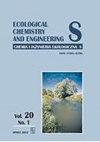Anthropogenic Impact on the Quality of Water and Agricultural Soil in Guadiana Valley, Durango, Mexico
IF 2.5
4区 环境科学与生态学
Q3 ENVIRONMENTAL SCIENCES
Ecological Chemistry and Engineering S-Chemia I Inzynieria Ekologiczna S
Pub Date : 2023-09-01
DOI:10.2478/eces-2023-0039
引用次数: 0
Abstract
Abstract One of the most important effluents in Guadiana Valley, Durango is El Tunal River, mostly used for agricultural and livestock supply. This river has been polluted by agricultural activity and wastewater discharges. Thus, this study aimed to evaluate the current quality of water and agricultural soil near the river, to estimate the environmental situation of the agricultural sector and its main pollution sources. Hence, a total of 24 soil and five water samples were taken, analysing parameters of organic matter, pH, nutrients, and heavy metals(loid)s (As, Cd, Pb, Zn) in five agricultural areas. The randomised experimental design showed significant variations in soil ( p < 0.05) of organic matter, nitrogen, As, and Pb between sampling points, confirming suitable conditions for agriculture. Although contamination by heavy metal(loid)s exists, it is below permitted levels. In contrast, the physicochemical quality of the water indicated high levels of phosphates, total dissolved solids, and total coliforms, mainly in the nearest site of a wastewater treatment plant, thus the quality of the water is not suitable for consumption and irrigation for sensitive crops. Nevertheless, rainfall contributes to improve the quality of the river by diluting pollutants. Moreover, constant use of this water might represent a risk to human health and agriculture as it could transport elements to crops or soil, becoming a severe environmental problem.人为活动对墨西哥杜兰戈瓜迪亚纳河谷土壤和水质量的影响
杜兰戈瓜迪亚纳河谷最重要的流出物之一是El Tunal河,主要用于农业和畜牧业供应。这条河因农业活动和废水排放而受到污染。因此,本研究旨在评价河流附近的水和农业土壤质量现状,评估农业部门的环境状况及其主要污染源。为此,在5个农业区共采集了24个土壤样品和5个水样,分析了有机质、pH、养分和重金属(As、Cd、Pb、Zn)的参数。随机试验设计显示土壤(p <采样点间有机质、氮、砷、铅含量为0.05),确定适宜农业生产的条件。虽然存在重金属污染,但仍低于允许水平。相比之下,水的物理化学质量表明磷酸盐、总溶解固体和总大肠菌群的含量很高,主要是在最近的污水处理厂,因此水的质量不适合消费和灌溉敏感作物。然而,降雨通过稀释污染物有助于改善河流的质量。此外,持续使用这种水可能对人类健康和农业构成风险,因为它可能将元素输送到作物或土壤中,成为一个严重的环境问题。
本文章由计算机程序翻译,如有差异,请以英文原文为准。
求助全文
约1分钟内获得全文
求助全文
来源期刊
CiteScore
2.80
自引率
36.80%
发文量
32
审稿时长
>12 weeks
期刊介绍:
The quarterly Ecological Chemistry and Engineering S is a multidisciplinary journal devoted to the publishing of original scientific papers, review articles, professional papers, case reports and varia (professional information, book reviews, etc.).
It is pertinent to describe methods determining quality of air, water, soils and food.
Many papers published are on monitoring and biomonitoring of an environment and on transfer of pollutants (eg heavy metals or radionuclides) from soil to plants. Some Authors consider impact of environment pollution on food and human health.
Some papers describe models of pollutant spreading in air or within soil. Others are devoted to various technologies to prevent or minimize industrial pollution, as well as to remediation techniques.
Papers on renewable energy sources are also very welcome.

 求助内容:
求助内容: 应助结果提醒方式:
应助结果提醒方式:


